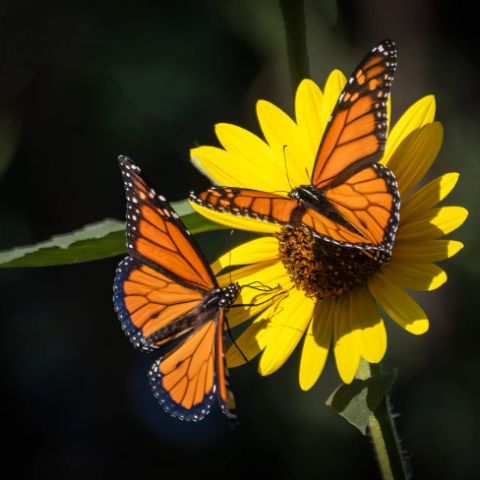Summary of OKC ZOO CREATES HEADSTART PROGRAM TO PROTECT RARE MILKWEED POPULATIONS IN OKLAHOMA:
The Oklahoma City Zoo and Botanical Garden has started a milkweed headstart project to bolster rare milkweed populations in Oklahoma. The project involves working with multiple partners to identify and collect seeds from rare milkweed species. The collected seeds will be germinated and reared in greenhouses, and the resulting seedlings will be planted in secure locations and monitored for survivability. The ultimate goal is to increase the population of vulnerable milkweed species and inform conservationists about rare milkweeds and the feasibility of milkweed headstart programs. In addition to the rare species, common milkweed species are available for planting in pollinator gardens to benefit monarch butterflies. The Zoo hosts a Monarch Awareness Day event to educate the public on their efforts and how individuals can help.
Summary:
1. The Oklahoma City Zoo has initiated a milkweed headstart program to protect rare milkweed populations in Oklahoma.
2. The program aims to reintroduce milkweed species of conservation concern back into the wild.
3. The Zoo is collaborating with various partners to locate and collect seeds from rare milkweed species.
4. The collected seeds will be germinated and reared in greenhouses, with seedlings planted in secure locations in the spring.
5. The ultimate goal is to increase the population of vulnerable milkweed species and serve as a model for other threatened plants.
In the vast world of nature and wildlife conservation, various unique and fascinating initiatives are taking place. One such endeavor is the OKC Zoo’s milkweed headstart program, which aims to protect rare milkweed populations in Oklahoma. This initiative is of utmost importance as it directly impacts the survival of the charismatic and threatened monarch butterfly.
Milkweed plants play a vital role in the survival of the monarch butterfly. With around 100 species of native milkweed in North America, Oklahoma is home to at least 25 of these species. However, many milkweed populations in the state are rare and endangered due to their location on the periphery of multiple species’ ranges. For instance, the purple milkweed, found in the southeast, is considered critically imperiled at the state level.
To address this issue, the Oklahoma City Zoo and Botanical Garden, in partnership with Oklahoma State University, The Nature Conservancy, and other organizations, has initiated a milkweed headstart program. This program involves bringing milkweed species of conservation concern into human care at an immature stage and later reintroducing them back into the wild.
The Headstart program follows best practices developed by the Center for Plant Conservation in Escondido, California. It involves identifying milkweed species of conservation concern native to Oklahoma, gaining access and permissions to lands, receiving permits for collection, and planning sites for future seedling reintroduction—the comprehensive program ensures collaboration with various stakeholders and organizations to maximize its impact.
The program commenced in the spring of 2023, with initial trips focused on searching for rare milkweed species using the last known locations and historical data. These efforts yielded positive results, with four species of conservation interest located, including purple milkweed, green milkweed, red-ring milkweed, and four-leaved milkweed. The plants were carefully documented with GPS coordinates, and a fine mesh bag was placed over selected seedpods to collect a small portion of the available seeds.
In August 2023, the team returned to the locations and successfully collected seeds from purple, green, and four-leaved milkweed. These seeds were then transported to greenhouses at the OKC Zoo, where they will be germinated and reared. The germination rates will be closely monitored, ensuring the successful growth of milkweed seedlings.
The next step in this headstart program is to plant the seedlings in secure locations during spring 2024. These sites will be carefully selected to promote the survival and growth of the milkweed species. The seedlings will be closely monitored to understand their survivability and assess the efficacy of the headstart program in bolstering the population of vulnerable to critically imperiled milkweed species in Oklahoma.
If successful, this milkweed headstart program will become a model for protecting other threatened and rare plants in the state. By demonstrating the importance and feasibility of such initiatives, the OKC Zoo aims to inspire other conservationists and organizations to take action to preserve our natural world.
While this program focuses on rare milkweed species, it’s essential to acknowledge the value of more common milkweed species as well. Oklahoma is blessed with several commercially available milkweed species that can be planted in pollinator gardens. These include butterfly, showy, swamp and common milkweed. Planting these species in gardens benefits monarch butterflies and contributes to pollinators’ overall well-being.
To raise awareness about the importance of monarch butterflies and how to help them, the OKC Zoo, in partnership with Bob Moore Subaru, is hosting a special Monarch Awareness Day on September 16. This event offers a variety of activities for all ages, including learning how to plant a pollinator garden, participating in the Monarch Watch’s community science monarch tagging project, helping with planting a pollinator garden in the Zoo, and even receiving free butterfly milkweed plants and pollinator seed packs. It’s a fantastic opportunity to get involved and make a difference.
In conclusion, the OKC Zoo’s milkweed headstart program is an exciting and impactful initiative that aims to protect rare milkweed populations in Oklahoma. By collaborating with multiple partners, the Zoo strives to increase the populations of vulnerable milkweed species and serve as a model for other threatened plants. Additionally, by planting more common milkweed species in pollinator gardens, individuals can actively contribute to the well-being of monarch butterflies and other pollinators. So, let’s join hands, take action, and ensure a thriving future for these beautiful creatures and the natural world they inhabit.


